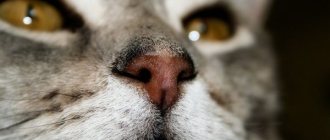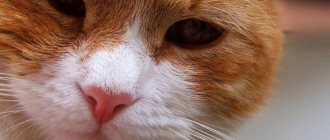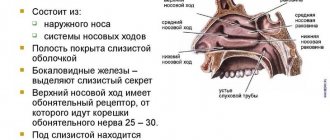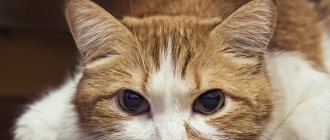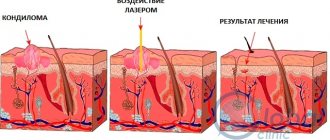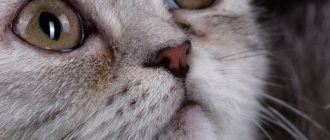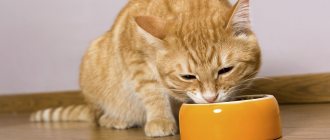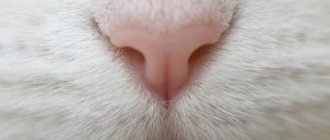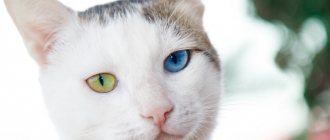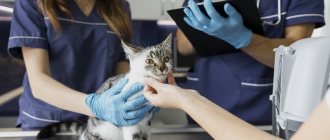Even people who have never had pets know very well that a cool, moist nose is an indicator of the health of the animal. The desire of cat owners to understand whether they should be concerned if the olfactory organ is warm and dry is understandable. Many diseases are accompanied by an increase in body temperature, at which this phenomenon occurs. But even a completely healthy cat can have a dry and warm nose. You need to be able to distinguish the symptoms of the disease from natural, safe changes in the temperature of the olfactory organ. This will help you take effective measures in a timely manner and avoid unnecessary concerns.
A cat's nose is an indicator of well-being
A cat's nose primarily performs an olfactory function. There are an order of magnitude more receptors in it than in humans, so it greatly helps the animal navigate its environment. Thanks to him, even kittens immediately after birth are not as helpless as they might seem. Despite the fact that they have not only sight, but also hearing, they find their mother using their nose.
The nasal sinuses are separated by a cartilaginous septum, and behind them are the ethmoid conchae. If the smell falls into this section, then the receptors transmit it to the brain, and what the cat sniffed is correlated with previously remembered smells and is determined. If the cat is a flat-faced breed, then its nasal bones are deformed, which makes it harder for it to breathe, and it also does not recognize odors so well.
But the nose also has other functions - protective and tactile. The air inside it is cleaned of dust and microorganisms, and also warms up. The tactile function is performed thanks to the lobe - with its help, cats determine the temperature of food.
It is the lobe that makes it possible to monitor the well-being of your pet. A healthy person should have:
- cool,
- wet,
- shine slightly
- have no crusts or scales.
It becomes wet for a reason, but because the mucous membrane secretes a special secretion. Thanks to it, a protective film appears - it protects the cat from adverse influences and retains foreign substances to identify their odors. Another reason for a cat's nose to be wet is that the cat herself often licks it.
Advice for caring owners
When communicating with our beloved pet, we don’t need words: we feel their love and affection, observe how playfully and carefree they show their habits, and admire their grace. As creatures of the wild, domestic cats live and experience this world through their baser instincts.
A happy pet creates the world around him through the care of his owner
You can get much closer and learn to understand your pet's signals and behavior by learning basic information about the structure of their amazing organisms. Regular care and attention to your pet will make you a rare guest in the veterinarian's office.
What causes your nose to become dry and warm?
A warm nose has a very simple explanation - it is associated with increased body temperature, as well as blood pressure. But this does not necessarily mean that the cat is sick - an increase in temperature can be caused by other reasons.
When the animal is normal
If we are talking about a kitten, then the matter may simply be that he does not know how to take care of his nose, because his mother used to do it. If they were separated early, this situation is quite possible, and if the kitten has a warm nose, then the owner needs to take care of moisturizing it, otherwise the nose may crack and hurt.
If a cat has a warm nose, but otherwise looks healthy - is active, has a good appetite, then the reasons may be:
- Excessive activity. With intense muscle work, the metabolism accelerates, resulting in rapid fluid loss and an increase in temperature.
- Sleeping too long. Processes in the animal's body slow down when it sleeps, and this also applies to the work of the mucous glands. Therefore, after waking up, the nose may be dry and quickly warm up - over time it will return to normal.
- The pet drinks little. It is worth making sure that he has enough fluid, because a lack of it can lead to dehydration.
- The room is too warm and dry. If moisture evaporates faster than secretions are produced, the cat's nose becomes dry. To prevent this from happening, it is better to keep pets away from heating appliances. An air humidifier also helps - in general, if a cat’s nose is dry due to the atmosphere in the room, then it is also unfavorable for people, so a humidifier will be useful for everyone.
- Stress. If a cat is worried, this is reflected in a change in its behavior; it can become aggressive, avoid people and other animals, and lick itself frequently. Stress can be caused by moving or a new occupant of the house - then it will pass over time. If the reason is different, it is worth eliminating it if possible, and sometimes using sedatives so that the pet does not remain depressed for too long.
- Estrus. Its onset can be determined by the behavior of the animal - this is usually not difficult to do.
When determining body temperature from the earlobe, you can only rely on sensations, which does not ensure accuracy. If the nose does not return to normal for a long time, it is worth measuring its body temperature using a rectal thermometer.
How to examine an animal yourself
Self-examination of the animal does not present any problems. The main thing is to pay special attention to measuring the temperature and humidity of the nose and studying the color of the mucous membranes. It is better to write down the results of the examination, along with other identified symptoms; in the future, these notes will help the specialist in making the correct diagnosis.
It may be difficult to measure your pulse. To palpate it, the femoral artery is best suited; to detect it you need:
- lightly press with your fingers in the area where the artery is located on the inner surface of the limb;
- Having detected the beating of the vessel wall, you need to time 10 seconds on a stopwatch and count the number of tremors during this period;
- the obtained data is multiplied by 6, so the number of heart beats per minute is obtained;
- A pulse from 120 to 140 beats/min is considered normal. It should be borne in mind that in kittens it will be more frequent, and in large breeds it will be rare.
Temperature measurement
One of the most important indicators of a cat's health is its body temperature. You can easily measure it yourself; the most accurate result is obtained using the rectal measurement method. You can even use a regular thermometer for it; only the measurement time depends on the type of device:
- 6 minutes. This is how much temperature you need to measure when using a mercury thermometer;
- 3 minutes. This time is sufficient when using an electronic thermometer;
- 10 Seconds. After this period, a special rectal thermometer gives results.
The procedure is not particularly difficult, but requires preparation and calming of the animal. Before inserting the thermometer into the rectum, its tip must be lubricated with Vaseline. The animal will need to be securely secured (for example, wrapped in a towel). You cannot insert the thermometer to a depth of more than 2.5 cm. The normal body temperature of a cat is 38-39 degrees.
After receiving the result, the device must be thoroughly disinfected and returned to the first aid kit. You need to be especially careful when handling mercury thermometers, as damage to them can lead to the spread of mercury throughout the house, the vapors of which are extremely toxic.
Dangerous causes of warm and dry nose
If none of the previously listed reasons apply, a warm nose may indicate an illness in your pet. You can roughly determine it by the symptoms, although you should consult a doctor to make an accurate diagnosis.
Fever is one of the symptoms of the following diseases:
- neoplasms in the nasal sinuses, or something may simply get stuck in them;
- injuries due to which secretion production decreases or stops;
- rhinitis, sinusitis;
- various types of inflammation and infectious diseases;
- diseases of the urinary system;
- gastrointestinal upset due to overeating;
- poisoning;
- trichobezoars in the stomach or intestines;
- tick infestation.
If you suspect that the cause of a warm nose is something from this list, you should show your pet to a doctor. The sooner the disease can be identified and treatment begun, the lower the likelihood of complications.
What signs may accompany a dry and warm nose?
You can guess the reasons for changes in the condition of the nose by the accompanying signs. If any of them indicate pathology, you should immediately consult a doctor. Let's list the main features.
Loss of appetite
Usually indicates that the pet is weakened. If he has a disease of internal organs, inflammation, or has caught an infection, then in addition to low appetite, this will be indicated by apathy, prolonged sleep and high temperature.
If the temperature is normal, it is worth remembering whether there has been anything recently that could cause stress in the cat. If this is the reason, the pet should be surrounded with attention, and it will quickly return to normal.
Ears too warm
If not only the nose is hot, but the ears too, then the cat has hyperthermia. The reason may be:
- colds or otitis media;
- trauma, hematoma;
- viral infection;
- stress;
- staying in a room that is too warm and stuffy for a long time.
Some of these reasons can be eliminated on your own, but in some cases you will have to go to the doctor.
Nose changed color
If the nose has acquired a bluish tint, this may be a sign of intoxication, yellow - kidney failure, redness indicates a burn, and pallor - a heart pathology.
Other symptoms
If the cause is a viral infection or damage to the gastrointestinal tract, vomiting and diarrhea are possible. If blood is visible in the vomit or stool, you should consult a doctor immediately, because this indicates damage to internal organs.
You can also determine something by the color of nasal discharge: it can be transparent, contain pus or sulfur. If your cat has a cold, its eyes may become red and breathing may become difficult. When infested with parasites, the quality of the coat deteriorates and it begins to fall out.
If the animal suddenly loses weight, has anemia, difficulty breathing, convulsions and paralysis, the cause may be a malignant neoplasm. A wobbly gait and increased salivation should also be a reason to consult a doctor because it indicates damage to the nervous system - its consequences can be very serious.
Excessively wet nose
It also happens that the nose is too wet - this can also indicate health problems. Causes of increased nasal moisture include:
- Cold - the earlobe does not dry out due to a runny nose and sneezing.
- Allergies can also be accompanied by a runny nose and sneezing.
- Hypothermia and poisoning can cause a drop in temperature, accompanied by increased moisture in the nose.
- Infections – sometimes they are characterized by a combination of a too wet nose and hot ears.
- Diseases of the heart and blood vessels - this is indicated by too pale mucous membranes.
- Polyps or foreign objects, as well as tumors. Because of them, mucus production may increase.
There are many options, so trying to cure your pet yourself is undesirable and even dangerous. If the cause is determined incorrectly, time will be lost and the animal’s condition will only get worse.
When you need to rush to the vet immediately
A dry nose of a furry pet does not always indicate a disease. In some cases, this condition is caused by natural causes, so there should be no cause for concern for the owner. The cat must be constantly monitored, and if in doubt, be sure to contact a veterinary clinic for diagnosis and treatment. After all, any wrong action towards a sick animal can cause significant harm to it and delay the recovery process for a long time.
See also: How to properly examine a cat after a fight
Actions to take if you suspect your pet is sick
You can try to reduce the temperature in the following ways:
- ventilate the room
- wet the wool with water,
- apply cold compresses to the armpits.
It is important to avoid dehydration. If the cat does not drink, it should be given water through a pipette or syringe. If crusts have formed on the lobe, use chlorhexidine or furatsilin to soak them. If your pet's condition does not improve, you should seek help from a doctor.
Antipyretics should not be given to cats unless prescribed by a doctor. Many drugs intended for humans are toxic to cats; their use will result in allergies or even poisoning, and if the animal is already sick, its condition can greatly worsen.
But you shouldn’t panic as soon as you discover that your cat has a dry and warm nose. First, just watch her, if there are no other signs of illness, perhaps everything will soon return to normal. But if you notice them, you should not hesitate to consult a doctor.
Additional hygiene procedures
When the cause of dry nose is poor hygiene, the owner should do it more regularly. To do this, the animal is placed on a hard surface and the visible part of the nasal passages is cleaned with extreme care using a cotton swab - the inside of the nose is not touched.
With light movements directed from the inner edge to the outer, you need to remove all dirt. The crusts are carefully soaked with furatsilin and removed. If as a result of these procedures the spout becomes too wet, excess moisture should be removed with a paper napkin. It is impossible to press hard on the nose and wipe with insufficiently careful movements, as such manipulations will cause an aggressive reaction. Napkins should not be colored or scented, as the dye or scent may cause allergies. Some experts advise using ordinary clean boiled water to clean your cat’s nose.
